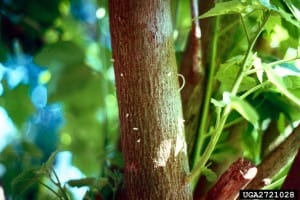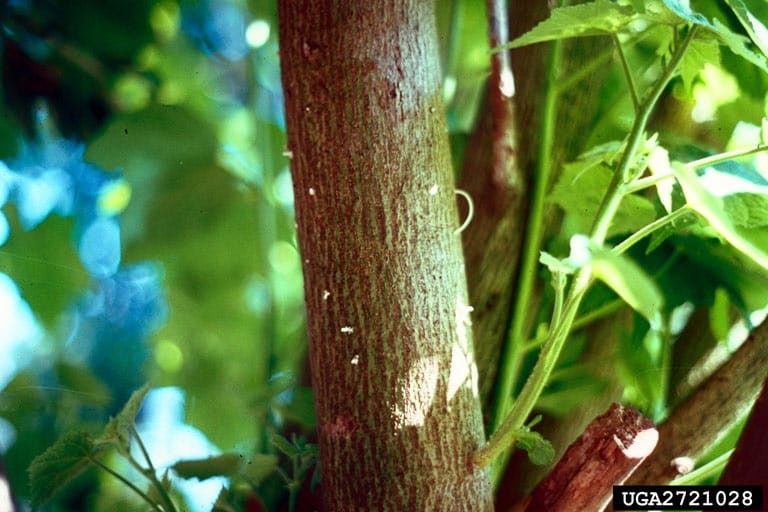Will Hudson, UGA Extension Entomologist
Asian or granulate ambrosia beetles are tiny (<1/8″) wood-boring insects that attack the trunks of young and weakened trees and shrubs. Ambrosia beetles tunnel into stems and construct galleries where they raise their young. Beetles carry on their bodies a fungus that grows in these galleries producing ambrosia which feeds both adults and larvae. Ambrosia beetles can also carry the spores of disease pathogens that infect the tree. The growth of these fungi can lead to weakening or death of the tree.

As ambrosia beetles tunnel, they push sawdust out through their entry hole. This sawdust can cling together forming short ‘toothpicks’ sticking from the infested stem. These toothpicks make it easy to identify ambrosia beetle attacks.
Wind or rain may destroy these toothpicks leaving just the small holes and scattered sawdust from the beetle. Since the entry holes are only about the size of a #2 pencil lead, close inspection is necessary to detect these attacks in time to treat. Ambrosia beetles attack many types of trees and shrubs including crape myrtles, cherries, oaks, sweet gums, pecans, peaches and others.
The ambrosia beetle’s first flight occurs with mild weather typically in February but possibly as early as January. Cold weather will put them off for a while, but we usually see a big emergence of the granulate ambrosia beetle ranging from February in south Georgia to early March in north Georgia.
Young trees in nurseries and trees that have been in landscapes for less than three years old are vulnerable to attack even if they are not obviously stressed. This is especially true during the green-up period. Prompt action can save these trees if the number of attacks (“toothpicks”) is less than 4 – 5 per tree.
Growers of nursery trees and shrubs, as well as landscapers with new trees, can apply a spray to protect vulnerable trees. The spray should be repeated every 10 – 14 days until the plants are completely leafed out.
If applied in time, pyrethroid insecticides can repel the beetles even after plants are attacked. Pyrethroids like permethrin (Pounce, Astro), Talstar, Decathlon, or others will work. Once the trees have leafed out completely, they are less attractive to the beetles unless the trees are under stress. Prevent stress to shrubs and trees to lower chance of ambrosia beetle injury.
Spray affected trees, being careful to cover the trunk completely. Monitor the trees for signs of wilting of the new leaves, a sign that a pathogen has been introduced. Once the wilting starts, the tree will probably die. Do not assume the attack will be fatal, since trees may recover. Also watch treated trees to see if new toothpicks develop – a sign that the ambrosia beetles are still active.
Nursery trees that are attacked should be sprayed and separated from the rest of the block (if possible), and watched closely for signs of wilting. Nursery trees that are attacked but don’t wilt may not need to be destroyed. If they leaf out and seem healthy and no further toothpick formation is noted, then the small holes will heal quickly and leave no permanent damage.
If you see toothpicks on larger trees, the tree is probably severely stressed. If attacks are confined to one limb, pruning is an option. If the attacks are on the main stem, prepare to remove the tree if it dies.
Considering the history of this pest in Georgia, there is a good chance that any given nursery or landscape will suffer little or no damage and spraying will not be necessary. Watch susceptible trees or shrubs closely for beetle attacks.
Traps can be used to monitor the activity of this pest. For more information on constructing Ambrosia beetle traps see Activity Monitoring in this publication.
